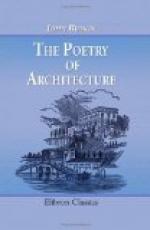24. This postulate being granted, as we are sure it will by most (and we beg to assure those who are refractory or argumentative, that, were this a treatise on the sublime and beautiful, we could convince and quell their incredulity to their entire satisfaction by innumerable instances), we proceed to remark here, once for all, that the principal glory of the Italian landscape is its extreme melancholy. It is fitting that it should be so: the dead are the nations of Italy; her name and her strength are dwelling with the pale nations underneath the earth; the chief and chosen boast of her utmost pride is the hic jacet; she is but one wide sepulcher, and all her present life is like a shadow or a memory. And therefore, or, rather, by a most beautiful coincidence, her national tree is the cypress; and whoever has marked the peculiar character which these noble shadowy spires can give to her landscape, lifting their majestic troops of waving darkness from beside the fallen column, or out of the midst of the silence of the shadowed temple and worshipless shrine, seen far and wide over the blue of the faint plain, without loving the dark trees for their sympathy with the sadness of Italy’s sweet cemetery shore, is one who profanes her soil with his footsteps.
25. Every part of the landscape is in unison; the same glory of mourning is thrown over the whole; the deep blue of the heavens is mingled with that of the everlasting hills, or melted away into the silence of the sapphire sea; the pale cities, temple and tower, lie gleaming along the champaign; but how calmly! no hum of men; no motion of multitude in the midst of them: they are voiceless as the city of ashes. The transparent air is gentle among the blossoms of the orange and the dim leaves of the olive; and the small fountains, which, in any other land, would spring merrily along, sparkling and singing among tinkling pebbles, here flow calmly and silently into some pale font of marble, all beautiful with life; worked by some unknown hand, long ago nerveless, and fall and pass on among wan flowers, and scented copse, through cool leaf-lighted caves or gray Egerian grottoes, to join the Tiber or Eridanus, to swell the waves of Nemi, or the Larian Lake. The most minute objects (leaf, flower, and stone), while they add to the beauty, seem to share in the sadness, of the whole.
26. But, if one principal character of Italian landscape is melancholy, another is elevation. We have no simple rusticity of scene, no cowslip and buttercup humility of seclusion. Tall mulberry trees, with festoons of the luxuriant vine, purple with ponderous clusters, trailed and trellised between and over them, shade the wide fields of stately Indian corn; luxuriance of lofty vegetation (catalpa, and aloe, and olive), ranging itself in lines of massy light along the wan champaign, guides the eye away to the unfailing wall of mountain, Alp or Apennine; no cold long range of shivery gray, but dazzling light




